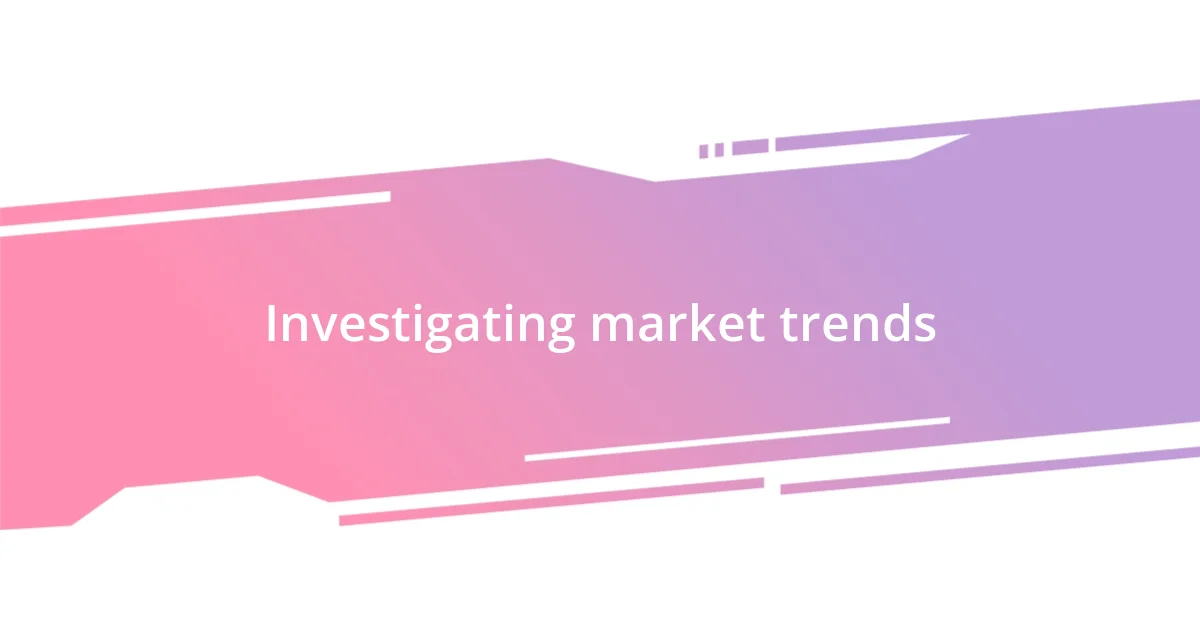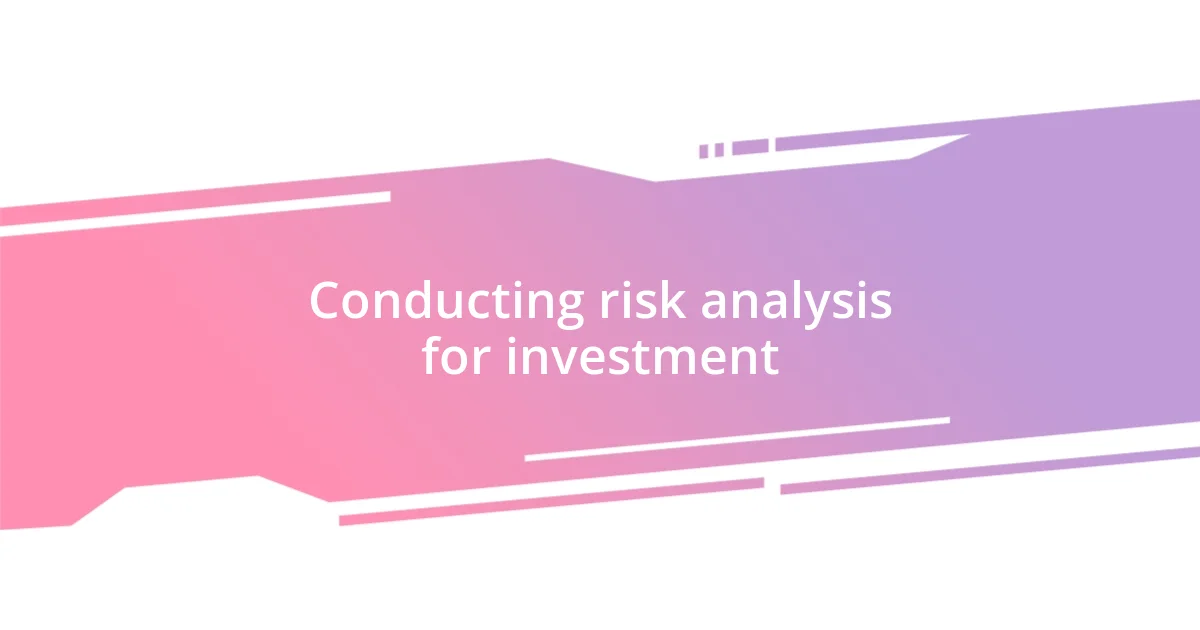Key takeaways:
- Understanding the community, team transparency, and NFT utility are crucial factors for evaluating the potential success of NFT projects.
- Key metrics such as floor price, trading volume, community engagement, and rarity significantly influence investment decisions in the NFT market.
- Conducting risk analysis involves assessing the project team, market conditions, and legal frameworks to ensure investment security and longevity.

Understanding NFT projects
Diving into the world of NFT projects, I quickly realized that understanding the community behind each project is crucial. I remember the moment I joined a Discord channel for an NFT collection; the energy and enthusiasm were palpable, and it became clear just how vital community support is. Have you ever felt that rush of belonging to a group that shares your interests? It’s that same connection that can make or break an NFT project.
When evaluating these projects, I look closely at the team behind them. I recall a project that caught my eye because of its transparent leadership and innovative vision. It felt comforting to see the faces and stories of the creators. It makes you wonder, how often do we overlook the importance of the individuals steering the ship? A strong, dedicated team can inspire confidence and drive a project’s success.
Lastly, the uniqueness and utility of the NFTs themselves truly speak to their potential value. One particular NFT I purchased stood out because it offered real-world perks, like exclusive event access. I think about how important it is to look beyond just the visual appeal; functionality and purpose can elevate a project significantly. What does it say about an NFT if it offers more than just a pretty picture? These aspects are central to making informed decisions in the vibrant and often volatile world of NFTs.

Key metrics for evaluation
When evaluating NFT projects, I pay close attention to the floor price and trading volume. I remember when I first tracked a project that had a suspiciously low floor price despite high trading volume. I felt that something was off, and diving deeper revealed a lack of genuine interest from buyers. It reminded me of a college class where the loudest students weren’t always the most knowledgeable. Do you find that some projects sound good on paper but struggle in the real market?
Another essential metric is community engagement. I’ve participated in various Discord servers, and I can tell you that a thriving community often translates to sustained interest and value. One project really stood out to me when their activity surged after a major event, sparking new discussions and collaborations. It’s like being at a party; if more people are having fun and sharing ideas, the vibes just get better. How engaged is the community around the projects you’re interested in?
Finally, I consider the rarity and scarcity of NFTs in a collection. I once bought an NFT that was part of a limited drop, and the feeling of owning something unique was exhilarating. It got me thinking about how rarity can drive perceived value. But I also reflect on how it differs from an overhyped collection that releases too many duplicates. So, what’s your take on rarity—does it enhance the appeal, or do you think it’s all about the art and utility?
| Metric | Description |
|---|---|
| Floor Price | Lowest price at which an NFT is available for sale in the market. |
| Trading Volume | The total value of all NFT sales for a project over a specific period. |
| Community Engagement | Level of activity and interaction within the project’s community, often found on platforms like Discord. |
| Rarity/Scarcity | The uniqueness of an NFT within a collection, influencing its value perception. |

Researching project teams
When diving into the project teams behind NFT collections, I find it essential to assess their backgrounds and track records. I recall collaborating with a tech-focused team on a small NFT initiative, and their passion for innovative technology really shone through. It made me realize how crucial it is to research not just their resumes but also their previous projects and successes within the industry. A team’s history can reveal their potential for future growth.
Here are some key aspects I consider when researching project teams:
- Transparency: Do they openly share their identities and backgrounds? This can indicate honesty and integrity.
- Experience: What prior projects have they worked on? A strong portfolio often correlates with future success.
- Community Involvement: Are they active in their project’s community? Engagement can foster trust and loyalty.
- Vision and Values: What are their goals? Understanding their mission helps me align with projects I feel passionate about.
- Diversity of Skills: Does the team possess a balance of technical and artistic talent? A well-rounded team is often more adaptable and innovative.
I also like to connect with team members on social media. I once reached out to a project’s founder after being inspired by their vision, and our conversation opened my eyes to their genuine commitment to the NFT space. Engaging with the people behind the projects adds a personal layer to the evaluation process, helping solidify my decision-making. It’s like building relationships in any industry – knowing that real people are driven by their passion makes me more willing to invest my time and resources.

Analyzing project community engagement
When evaluating community engagement, I look for not just numbers, but genuine interactions. For instance, I participated in an NFT project’s launch event where the energy was palpable. The chats were buzzing with excitement, and I remember feeling a sense of belonging as I exchanged ideas with other enthusiasts. This made me think: how often do we see projects where the hype quickly dissipates after launch? Genuine engagement can keep that energy alive.
I also pay close attention to how community members support each other. In one particular Discord group, I noticed how seasoned collectors mentored newcomers, creating a nurturing environment. It felt like being in a thriving ecosystem where everyone contributed to the growth of each other. Isn’t it fascinating how that kind of support can not only enhance individual experiences but also bolster the entire project?
It’s also worth considering how long the community has been active. I’ve watched projects that started strong but then faded away when the initial excitement wore off. One time, I invested in a project that seemed promising initially, but over time, the conversations dwindled, leaving me questioning my choice. Consistent engagement indicates a robust community, while a decline can be a red flag. What about you—have you experienced the same ups and downs in community involvement?

Investigating market trends
When examining market trends, I believe it’s essential to look at overall sentiment within the NFT space. Recently, I noticed a surge in interest for eco-friendly projects, which makes sense considering the growing awareness around sustainability. It got me thinking about how often we see market shifts that reflect broader societal concerns, and it’s fascinating to see which projects capitalize on those trends.
I often find myself monitoring the fluctuations in trading volumes and floor prices—these metrics can tell a story that goes beyond the surface. For example, I recall tracking a particular collection that saw a dramatic increase in trades during a viral event in the community. It was a real eye-opener for me; sudden spikes like that can indicate a sudden shift in popularity but also reveal the volatility of the market. Have you ever experienced the thrill of following a project’s rise, only to see it tumble shortly after? It’s a potent reminder that trends can be temporary.
Furthermore, I delve into social media channels and NFT marketplaces to gauge public perception and hype. I vividly remember joining Twitter Spaces within a burgeoning project’s community and witnessing the palpable excitement from the participants. It was a blend of optimism and anticipation that fueled my interest. It makes me wonder: how much do external factors, like influencer endorsements or partnerships, shape the direction of a project? Understanding these dynamics is key for me when evaluating potential investments.

Assessing utility and roadmap
When I assess the utility of an NFT project, I often reflect on whether the tokens offer real-world benefits beyond mere ownership. For instance, I remember exploring a project that promised exclusive access to events and collaborations with artists, which instantly piqued my interest. It made me think: how often do projects fail to deliver value after the initial sale? I’ve seen too many that have great art but lack substance, and it’s a crucial aspect I now prioritize.
The roadmap is another critical piece I analyze closely. I once encountered a project with a detailed plan that included milestones like educational resources and community voting rights. This made me feel a sense of security, knowing there was a clear path forward. It raises an essential question: how vital is it to have transparent goals for keeping the community engaged? From my experience, robust roadmaps can often predict a project’s longevity, while vague plans can lead to disappointment down the road.
I also find it helpful to look at how adaptable a project’s roadmap is to changing market conditions or community feedback. There was a time when I invested in a project that tweaked its roadmap based on community input, and I felt a surge of enthusiasm. It’s astonishing how respecting the voice of the community can foster loyalty and trust. Have you noticed projects that listen to their followers? Those are often the ones with staying power, reflecting the dynamic nature of the NFT landscape.

Conducting risk analysis for investment
When I conduct risk analysis for an NFT investment, my first step is always to evaluate the project’s team. I’ve encountered projects where the lack of transparency about the creators made me hesitate. It leads me to ask: how can you invest in something when you don’t know who’s behind it? In my experience, a strong, credible team can significantly lower the risk factors, as their past successes or failures provide critical context.
Next, I consider the broader market conditions. I remember a specific time when I invested in a seemingly solid project, but soon after, a major market downturn hit. The value of my investment plummeted overnight, which was a harsh reality check. It made me realize that understanding the market’s pulse is just as crucial as knowing the project itself. What signs do you look for that might indicate trouble beyond the project’s control?
Lastly, I delve into the legal side of things, particularly around copyright and intellectual property rights. I once overlooked this important aspect and found myself in a situation where the project’s legitimacy came into question. It was an uncomfortable moment that taught me an invaluable lesson—always make sure a project has solid legal standing. Have you ever thought about how a project’s legal framework impacts its potential longevity? From my perspective, thorough legal analysis can play a pivotal role in mitigating risk, ensuring that the investment remains secure over time.














